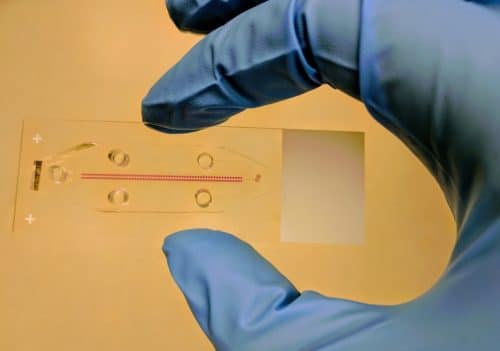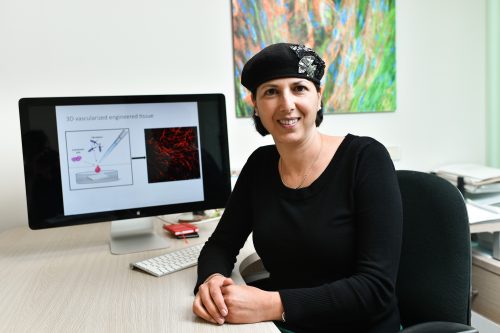Targeted antibiotics: preliminary monitoring of bacterial resistance to antibiotics and quick and accurate adjustment of the necessary medicine - these are the main points of an article published yesterday by Prof. Shulamit Levenberg from the Faculty of Biomedical Engineering at the Technion in the journal PNAS.

Antibiotics are one of the most effective ways to treat bacterial infections. However, the widespread use of antibiotic drugs accelerates the development of bacterial strains that are resistant to specific types of antibiotics. In 2014, antibiotic-resistant infections (AMR) claimed the lives of more than 700,000 people worldwide. This is in addition to a cumulative expenditure of approximately 35 billion dollars per year in the US alone.
Early treatment is an important component of recovery. According to established estimates, every hour of delay in administering the antibiotic reduces the survival rates of patients suffering from septic shock by approximately 7.6%. Therefore, in order not to leave the patient without protection, many doctors provide their patients, while waiting for the results, "broad" antibiotics in large doses. This phenomenon accelerates the formation of bacterial resistance to antibiotics and also damages the microbiota - the population of "good bacteria" that is present in the human body and protects it.
In this context, the importance of technologies that can identify in advance the degree of resistance of a specific bacterium to a specific antibiotic is understood. This is where the innovative system developed at the Technion comes into play: SNDA-AST. This system analyzes the bacteria's resistance to specific types of antibiotics and thus allows the treatment team to choose the most effective type, and this in a much shorter time than conventional methods. In addition, the researchers demonstrated the ability of the system to test the bacteria directly from raw urine samples, thus skipping the stage of their isolation. In the case of a urinary tract infection, the test is shortened by a few days.
The research was led by the dean of the Faculty of Biomedical Engineering at the Technion, Prof. Shulamit Levenberg, and was carried out by three researchers in her laboratory: doctoral student Yonatan Avisher, post-doctoral student Dekel Rosenfeld, and doctoral student Tom Ben Aryeh. The research was conducted in collaboration with Associate Professor Moran Berkowitz from the Faculty of Mechanical Engineering at the Technion and Ph.D. student Mariana Truman-Rozentziv and with the collaboration of Dr. Yuval Gefen, head of the microbiology laboratory at Rambam Medical College. It was held with the funding of a Kamin grant from the Innovation Authority and the I-CORE Centers of Excellence.
Avisher, born in the USA and who came to Israel to study at the Technion, explains: "Every day, dozens (or hundreds) of tests are conducted in every hospital in Israel designed to map the resistance levels of contaminating bacteria in samples taken from patients. The problem is that this is a very long test, as it is based on sending the sample to the laboratory, growing a culture of bacteria in a Petri dish and analyzing the culture. This process requires a relatively large sample and usually takes several days, partly because the working day in the laboratories is limited to eight hours. Our method, on the other hand, provides accurate results in a short time based on a much smaller sample. It is clear that a faster answer makes it possible to start the treatment earlier and improve the speed of recovery."
The device developed by the Technion researchers is a chip inside which are hundreds of tiny nanoliter sized holes (a nanoliter is one thousandth of a milliliter). A few bacteria and a specific antibiotic are inserted into each of the holes. The identification of the bacterial reaction is done using a fluorescent marker, image processing tools and statistical analysis of the colors obtained from the bacteria in all the tiny holes.
In a study in which 12 bacteria-antibiotic mixtures were tested in the system, it was found that the results, obtained as mentioned in a short time, are accurate and enable early and effective treatment of the bacteria causing the infection. According to Avisher, "The use of the technology we developed reduces by several orders of magnitude the size of the required sample, shortens the scanning time by about 50%, significantly reduces the laboratory areas needed for testing and lowers the cost of each test."


3 תגובות
Fast commercialization, after the registration of the patents. Sounds like something the Technion could make a lot of money from.
T3 is probably already thinking about it.
And of course and most importantly saving the lives of millions of people around the world.
The Technion must register patents on it (it may have already been done) and commercialize it as quickly as possible.
It sounds like something that every hospital in the world would be happy to purchase, because it reduces costs and the time the patient stays in the hospital.
You have to see the positive side of bacteria and viruses in regulating the population of the earth
Thanks to them you exist, who left genetic garbage in the body that contributed to the evolution of man
Bacteria play a significant role in the functioning of the human body
and keeping the earth in its life-supporting state